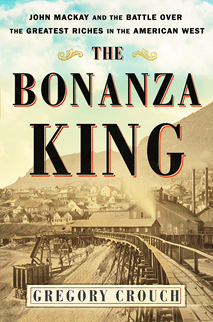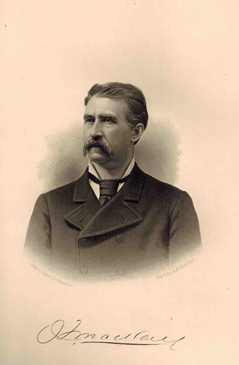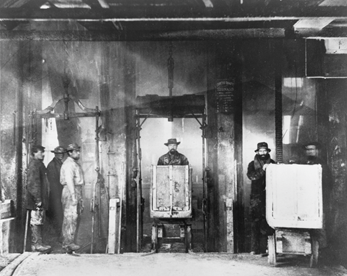The Big Bonanza: The richest mineral discovery in American history

Click here to buy a copy of The Bonanza King by Gregory Couch
Excerpt from THE BONANZA KING: John Mackay and the Battle Over the Greatest Riches in the American West by Gregory Crouch.
Mining explorations have always been massive gambles, even on the Comstock Lode, the legendary vein of gold and silver ore running beneath the mountainside town of Virginia City, Nevada,the most important town in the young state. In 1872, John Mackay and his three partners invested everything they’d “raised” from their previous mining ventures in the Consolidated Virginia mine. In the early days, it had yielded some good ore, but it had never been prospected below the 500-foot levels.
In the fall of that year, Con. Virginia miners struck “good indications” on the 1,167-foot level. Sometimes, low-grade finds presaged a significant body of ore. Other times, they proved to be will-o-the-wisp tantalizations that tempted miners to pour money into barren mines without ever condensing into a profitable ore body. Mackay and James Fair were the two miners in the four-man partnership. Not really knowing the extent of what they’d struck, they spent the next two years supervising the development of the strike. By late 1874, they knew they knew they’d found something with staggering implications.
Like John Mackay, Dan de Quille had been on the Comstock for well over a decade, and the sight stopped his pencil and stilled his tongue. He’d never seen anything like it. Not a pebble in the crosscut was worth less than $600 per ton
Mackay and his partners fancied themselves legitimate businessmen, not stock or corporate manipulators. They intended to make money from actual mining, and to prove it they did something “hitherto unknown” in Comstock history—they threw the Con. Virginia open to inspection by anybody willing to make the terrifying descent into the mine. Among the first party Mackay took down was Dan de Quille, the leading journalist of the Territorial Enterprise, Virginia City’s most important newspaper.

‘The Bonanza King’ Image courtesy of Nevada Historical Society
Supervised by Mackay, the visitors grasped the crossbar of the cage and rattled down the shaft to the 1,500-foot station. From there, Mackay led them east into Crosscut No. 1, “the California Crosscut,” which went east along the Con. Virginia’s boundary with the California Mine. Just over 100 feet past the intersection, the crosscut entered the ore body. De Quille described the first few feet as “moderately rich.” Beyond that, the walls grew into a pale green chloride ore shot through with streaks and nodules of black silver sulphurets upon which glittered bright points of iron and copper pyrites. The crosscut penetrated 25 feet into the ore body, and the walls, ceiling, floor, and face, all of it, was the same lively, sparkling ore.
Like John Mackay, Dan de Quille had been on the Comstock for well over a decade, and the sight stopped his pencil and stilled his tongue. He’d never seen anything like it. Not a pebble in the crosscut was worth less than $600 per ton, a sum with an emotional impact equal to about $100,000 modern dollars, and no small sample could be reasonably assayed for fear of grabbing a sulphuret nodule that would run the chunk into the thousands of dollars per ton. De Quille and the other visitors gazed on the ore in quiet awe until one of them broke the silence. “It makes a poor man sick to look at it,” he said.

Image courtesy University of Nevada, Reno Special Collections
The mining men on Mackay’s tour could see that between the systematic array of drifts, crosscuts, upraises, and winzes with which he and Fair had probed, prospected, and grid-worked the ore body in preparation for large-scale extraction lay vast quantities of proven, untouched ore. A flurry of reports described the Con. Virginia’s ore body as “simply wonderful” and “surpassing belief,” “extravagant,” “magnificent,” “vast,” “wondrous,” “almost incalculably rich,” “apparently limitless,” “of the richest possible description,” “beyond computation,” and, “if possible, growing richer.” John Mackay hadn’t seen ore that good since he’d been a common miner working “the old Mexican chimney” just below the surface in 1860 and 1861 for four dollars a day, and back then, he hadn’t seen but a tiny fraction of the enormous volume of top-quality ore he saw now. The value of the ore “in sight” beggared imagination. Nor had Mackay and Fair yet found the ore body’s eastern or northern edges.
To the Daily Alta California, it was “the great discovery of the age.” When Dan de Quille wrote about it after emerging from the mine, he called it “the richest mineral discovery in the world’s history.” Dan de Quille called the strike “the great bonanza” in the letter he sent to the San Francisco Chronicle on December 6, but within a month, he’d settled on a less pretentious but much more beautifully alliterated moniker—“the Big Bonanza.”
Predictably, the “stupendous mass of ore” provoked a delirium. Hope for sudden fortune was California’s oldest fever. Lust for a chance at something similar loosed people from their senses. Hopeful miners located silver ledges all over the West, incorporated mining companies, and foisted stock on a people clamoring for a chance at riches equal to those found in the Con. Virginia. Both rock and paper would prove worthless in almost every instance, but that wasn’t apparent in the first blush of those bonanza times.
It was “the great discovery of the age.” When Dan de Quille wrote about it after emerging from the mine, he called it “the richest mineral discovery in the world’s history.”
Euphoria propelled the values of every Comstock mine up fantastic parabolas. Nor did all of that wealth exist on paper: Virginia City shipped about ten tons of bullion to San Francisco per week, valued at half a million dollars, the vast majority of which had been raised from the Consolidated Virginia mine. John Mackay could scarcely move about the streets of Virginia City or San Francisco during those heady days. Everywhere he went, people buttonholed him for stock-buying advice.
He told them all the same thing: “Go and put your money in a savings bank.”
Most who received the advice stared at him agog, surprised, if not outright resentful, that such an eminent miner wouldn’t share his opinions. “They evidently consider me a strange kind of mining man,” Mackay told Dan de Quille, “but in speaking so I mean just what I say, and my advice is good. I never advise people to buy mining stocks of any kind.
“My business is square, legitimate mining,” he added. “I make my money here from the mines—from the ore itself.”
Not even cautionary advice from John Mackay himself could throw cold water on the booming market for mining stocks, however. As the market peaked, the total capital value of the Comstock’s leading thirty-one mines surpassed $262 million—$70 million more than the assessed value of all the real estate in the city of San Francisco
The realization that the incredible ore existed only in the Con. Virginia and California mines brought values crashing back to earth. The bursting bubble ruined many people, most of them of small means. But what an ore body it was! Crosscuts on the 1,500-foot level revealed the Big Bonanza spanning the entire length of the California mine. Mackay’s meticulous prospecting revealed the ore body’s colossal dimensions: 1,200 feet long, 600 feet tall at its deepest point, and although in most places “only” about 200 feet wide, its widest point was fully 340 feet across. Getting that stupendous quantity of ore out of the ground from depths that ranged from 1,100 to 1,700 feet underground was one of the greatest challenges miners had ever faced.
Directing the job absorbed John Mackay’s professional attention for most of the next five years. From the ore, Mackay reduced about $110 million worth of gold and silver. (A proportionally equivalent slice of modern GDP would be about $204billion dollars.) Mackay’s share of the profits ran to about $25 million. He once remarked to a New York journalist that with what he took out of the bonanza, he could have rebuilt Trinity Church from basement to spire top in solid silver. Throughout the West, people began referring to him as “the Bonanza King”—and with good reason—the Big Bonanza made John Mackay one of the richest men in the world.
(By Gregory Crouch)
Excerpt from THE BONANZA KING: John Mackay and the Battle Over the Greatest Riches in the American West by Gregory Crouch. Copyright © 2018 by Gregory Crouch. Published by Scribner, an imprint of Simon & Schuster, Inc
{{ commodity.name }}
{{ post.title }}
{{ post.date }}




Comments